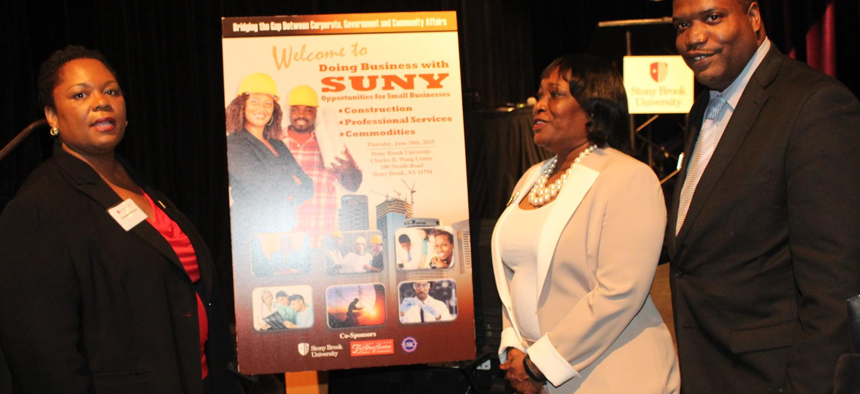New York City
NYC awarded less than 4% of contracts to minority- and women-owned business
Last year was a slow year for MWBEs, and Mayor Eric Adams said he wants to grow the program.

Phil Andrews, far right, is the president of the Long Island African American Chamber of Commerce and said they city has to be more accountable. Long Island African American Chamber of Commerce
When Gov. Kathy Hochul announced the state had reached its 30% goal for minority- and women-owned business enterprises last year, Albany had a lot to be pleased about. But that news also came as a reminder that New York City has a lot of catching up to do. In fiscal year 2021, New York City awarded only 3.8% of city contract money to MWBE firms, and 84% of the city’s MWBEs “do not have access to city spending,” according to the city comptroller’s office. Although New York City’s certified MWBE firms have tripled since 2015 – from 4,000 to 11,000 – only about 2,000 firms have received contracts from the city.
So why was the state able to reach its MWBE goal but the city struggled?
Both the city and state have different laws for certifying MWBEs. The state has Article 15-A, which requires state agencies to make sure MWBEs meet their employment and participation goals. Lourdes Zapata, who was the executive vice president of the Division of Minority and Women’s Business Development at Empire State Development, said that’s where the difference lies.
“It is very much a top-to-bottom approach and requirement in terms of MWBE engagement,” said Zapata, who now is the president and CEO of the South Bronx Overall Economic Development Corp. “The agencies at the city level are very decentralized, and so there’s not one person within city government that has the City Hall leverage to require city agencies to engage MWBEs in any real significant amount.”
Phil Andrews, the president of the Long Island African American Chamber of Commerce, agreed that city agencies needed to be held accountable.
“There are a lot of agencies where people are maybe sitting behind a desk and not allocating the money to minority firms,” he said. “But I think (the money) definitely needs to be strictly monitored (so) that each agency reaches its goals.”
The city has had several challenges during the past six months: Along with the pandemic, there is also the concern of inflation, which is at a 40-year high, labor shortages and supply chain issues. Those issues have particularly hurt the construction industry.
Louis Coletti, the president and CEO of the Building Trades Employers’ Association, said on top of the current issues, MWBEs struggled to obtain contracts from the city.
“MWBE contractors historically have not competed for the $40 billion to $50 billion project labor agreement money that’s out there between the city of New York and some of the airport work,” he said. “What COVID has done has just exacerbated the problem. The cash flow is horrible; opportunities are scarcer. So I think meeting the MWBE goal is going to be quite a challenge.”
But now, New York City has a new mayor, and Eric Adams has said that he will make the city’s MWBE program a major focus of his administration. What could the mayor do to make improvements? Zapata said adding some senior-level oversight and authority would probably be the most effective.
“City government, like state government, is a slow-moving ship. To get it to move is going to take a lot of power and a lot of pressure,” she said. “The bureaucracy is certainly moving in that direction. But it does require a lot of leverage and the kind of authority to make sure the agencies understand what the rules are and they apply it.”
Wallace Ford, a professor at Medgar Evers College, would like to see a mentoring program where MWBEs support each other in building their businesses. He also said the city should help facilitate those relationships and offer business opportunities, fiscal support for smaller businesses as well as technical assistance or partnerships.
“It’s not just about doing it because it’s the good thing to do,” he said about the city giving more contracts to MWBEs “It’s an economic generator with spinoff effects that are incalculable.”
Magalie Austin, director of the Mayor’s Office of M/WBEs, told City & State: “Mayor Eric Adams has articulated his ongoing commitment to ensuring that there’s true and transparent accountability in the City’s MWBE program, providing customized support to M/WBEs wherever possible, leveraging technology where needed to advance our shared goals, and collaborating with partners at the State level wherever feasible to maximize M/WBE certification and utilization outcomes.
“Mayor Adams has been clear that he unequivocally supports growing the City’s M/WBE program.”

NEXT STORY: Eric Adams has lower approval ratings than three of four previous NYC mayors: poll

